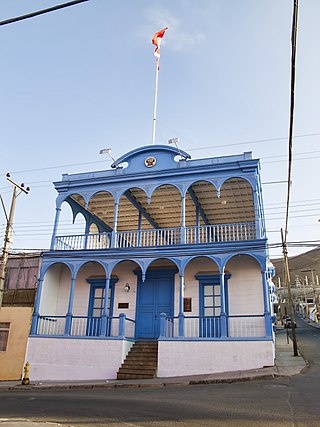
Oruro or Uru Uru is a city in Bolivia with a population of 264,683, about halfway between La Paz and Sucre in the Altiplano, approximately 3,709 meters (12,169 ft) above sea level.

Tacna, officially known as San Pedro de Tacna, is a city in southern Peru and the regional capital of the Tacna Region. A very commercially active city, it is located only 35 km (22 mi) north of the border with Arica y Parinacota Region from Chile, inland from the Pacific Ocean and in the valley of the Caplina River. It is Peru's tenth most populous city.

The Alto de la Alianza Monumental Complex is a historical monument and landmark complex in the south of Peru, near the city of Tacna.

Tacna is the largest of four provinces in the Department of Tacna in southern Peru located on the border with Chile and Bolivia. Its capital is Tacna.

The National Museum of Archaeology, Anthropology, and History of Peru is the largest and oldest museum in Peru, housed at the Palacio de la Magdalena, located in the main square of Pueblo Libre, a district of Lima, Peru. The museum houses more than 100,000 artifacts spanning the entire history of human occupation in what is now Peru. Highlights include the Raimondi Stele and the Tello Obelisk from Chavín de Huantar, and an impressive scale model of the Incan citadel, Machu Picchu. As of 2023, the museum is under restoration and very few rooms are open for visitors.

The Battle of Tacna, also known as the Battle of the Peak of the Alliance, effectively destroyed the Peru-Bolivian alliance against Chile, forged by a secret treaty signed in 1873. On 26 May 1880, the Chilean Northern Operations Army led by General Manuel Baquedano González, conclusively defeated the combined armies of Peru and Bolivia commanded by Bolivian President, General Narciso Campero. The battle took place at the Inti Urqu (Intiorko) hill plateau, a few miles north of the Peruvian city of Tacna. As a result, Bolivia was knocked out of the war, leaving Peru to fight the rest of the war alone. Also, this victory consolidated the Chilean domain over the Tarapacá Department. The territory was definitively annexed to Chile after the signing of the Tratado de Ancón, in 1884, which ended the war. Tacna itself remained under Chilean control until 1929.

The National Railway Museum of Peru is located in Tacna, Peru.

Esmeralda was a wooden-hulled steam corvette of the Chilean Navy, launched in 1855, and sunk by the Huáscar on 21 May 1879 at the Battle of Iquique during the War of the Pacific.

The Gold Museum of Peru and Weapons of the World, also known simply as the Gold Museum of Peru is a Peruvian archaeology and war museum located in the neighbourhood of Monterrico, Santiago de Surco, Lima.
Julio Mario Luqui-Lagleyze is an Argentine historian. Born in Buenos Aires in 1959 received a degree in History in 1982. He specializes in Hispano-American Military and Naval History and Military Museology. He is currently studying for his PhD in History at the Universidad Católica Argentina.
Zela House, also called Zela City Museum, is a museum located at San Martín Avenue, in the historic centre of Tacna, Peru. The building is a former residence of Francisco Antonio de Zela, who participated in the 1811 Tacna rebellion, an important episode preceding the Peruvian War of Independence.

The National Afro-Peruvian Museum is a museum dedicated to the acquisition, preservation and exhibition of objects related to the history of African descendants in Peru. Its headquarters is located in the House of the Thirteen Coins located on Ancash Street in the historic centre of Lima. It was inaugurated on 4 June 2009.

The National Museum of Peru is a national museum in Lurín District, Lima, Peru, located within the archaeological zone of Pachacamac. The museum will hold over a half million artifacts of the Pre-Columbian era and Inca Empire, ranging back to 5,000 BCE. It opened in July 2021 as part of Peru's bicentennial celebrations and is capable of accepting 15,000 guests per day.

Intiorko Hill is located at Ciudad Nueva District in Tacna Department, located in southern Peru. At 780 metres above sea level, the stone used for the construction of the Tacna Cathedral, the Parabolic Arch and the Tacna Prefecture comes from the hill.

The Crypt of Heroes is a war monument located at Intiorko Hill, Tacna, Peru. Originally inaugurated by the Chilean administration in 1901 and rededicated in 1930 by the Peruvian government, the monument is currently partially destroyed.

The Combatants of the Morro de Arica Museum, also known as the Casa de Bolognesi, is a house museum dedicated to the War of the Pacific and its battle of Arica, located at the birthplace of Francisco Bolognesi, in the historic centre of Lima, Peru.

The Museum of Congress and the Inquisition, also known as the Monumental Museum of the Inquisition and Congress, is a museum located at the former headquarters of the Tribunal of the Holy Office of the Inquisition in the neighbourhood of Barrios Altos, part of the historic centre of Lima, Peru. Located at the fifth block of Jirón Junín, next to the Plaza Bolívar, it is dedicated to the histories of both the Tribunal and the Congress of Peru.

The Casa Bolognesi, also known as the Casa de la Respuesta, is a historical building owned by the Peruvian State located in Arica, Chile. It is the site of a meeting that preceded the Battle of Arica during the War of the Pacific.

Andrés Avelino Cáceres Museum is a war museum located at a building formerly used as a train station at the Parque Reducto № 2 in Miraflores District, Lima, Peru. It is named after Marshal Andrés Avelino Cáceres, who participated at the park's defense during the War of the Pacific, then used as a redoubt.


















